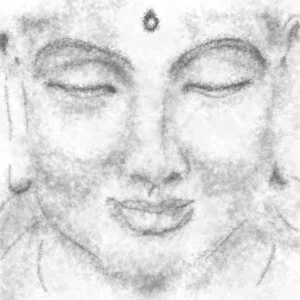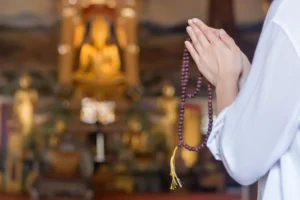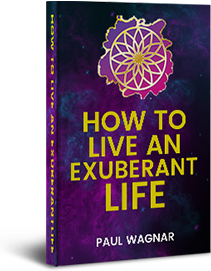There are times when the past feels like a weight pressing upon us – the mistakes we regret, the words we cannot take back, the karmas rippling through our lives like echoes from another age. In such times, the Sapta Atita Buddha Karasaniya Dharani is a direct and merciful medicine.
This dharani, sometimes called the Sapta Jina Bhasitam Papa Vinasana Dharani or the Dharani of the Seven Past Buddhas to Eradicate Sins, is not just a chant of remembrance – it is a chant of liberation.
By invoking the names and power of seven Buddhas who lived before Shakyamuni, we are reminded that the Dharma is timeless, and that healing flows not only from the present Buddha but from an unbroken lineage stretching across vast kalpas.
To recite this dharani is to call upon an ancient chorus of awakened beings to help us dissolve karmic stains, to wash away the invisible burdens of our past, and to stand once again in the clarity of virtue.

The Spiritual Power of Dharanis
Unlike longer sutras, a dharani condenses vast spiritual power into compact syllables. The Sapta Atita Buddha Karasaniya Dharani is deceptively short, but it functions like a lightning strike. It penetrates the subtle body, cutting through the fog of accumulated karmas and awakening hidden reserves of compassion.
Modern practitioners sometimes underestimate the potency of these “small mantras,” but Buddhist masters have long insisted that they contain the very marrow of liberation. Even a single sincere recitation can turn the heart toward virtue.
Lineage and History Of The Sapta Atita Buddha Karasaniya Dharani
The Sapta Atita Buddha Karasaniya Dharani appears in important Mahayana sources, including the Collection of Facts Upper Division (Taisho Tripitaka T53n2122) and the Sutra of The High King Avalokitesvara (Taisho Tripitaka T85n2898). It is also one of the Ten Small Mantras of Mahayana Buddhism – mantras that are short, easy to learn, and potent enough to carry vast blessings.
The dharani honors seven Buddhas:
- Vipasyin Buddha
- Sikhin Buddha
- Visvabhu Buddha
- Krakucchandra Buddha
- Kanakamuni Buddha
- Kasyapa Buddha
- Shakyamuni Buddha
In Buddhist cosmology, these Buddhas are part of a long succession of enlightened beings who have appeared in previous ages, each embodying compassion and wisdom for their time. By invoking them together, the practitioner stands in the middle of an unbroken stream of light flowing across eternity.

The Dharani in Its Original Form
Sanskrit Text
Ripa ripa te
kuha kuha te
trani-te
nigala-te
vimari-te
maha-gate
jam-lam cam-te
svaha
Invocation of the Seven Buddhas (Sanskrit & Transliteration):
Namo Vipasyin Buddha
Namo Sikhin Buddha
Namo Visvabhu Buddha
Namo Krakucchandra Buddha
Namo Kanakamuni Buddha
Namo Kasyapa Buddha
Namo Sakyamuni Buddha
English Translation
Calling, calling out
Revealing, revealing all
Making heartfelt prayers
Dissolving, disappearing blame
Vanishing vanished blame
Eminent virtues appear
and all blame is truly buried
and gone by this power
So be it!
The Essence of the Teachings Of The Sapta Atita Buddha Karasaniya Dharani
The dharani has a simple yet profound rhythm: it is about calling, revealing, dissolving, and transcending.
- Calling, calling out – We cry from the heart to the Buddhas of the past, acknowledging our dependence upon their compassion.
- Revealing, revealing all – Nothing is hidden. To chant is to bring even our deepest shadows into the light of awareness.
- Making heartfelt prayers – The dharani is not mechanical repetition; it is an act of genuine devotion and surrender.
- Dissolving blame – Karma, guilt, shame – all these dissolve in the presence of awakened beings.
- Virtues appear – As obstacles vanish, the natural radiance of the heart emerges.
The teaching is clear: when we stop hiding, when we lay ourselves bare before the lineage of Buddhas, our karmic stains lose their power and our original purity reasserts itself.
Benefits of Chanting The Sapta Atita Buddha Karasaniya Dharani
- Eradication of Karmic Obstacles
The dharani is explicitly named as a practice for dissolving karmic hindrances. This includes not only personal mistakes but also karmas inherited from family, community, and collective pasts. - Release from Shame and Guilt
Unlike some traditions that emphasize punishment, this practice emphasizes release. Chanting transforms shame into humility and guilt into compassion. - Alignment with the Seven Buddhas
Each Buddha represents a quality of awakened presence – by chanting, we align ourselves with their timeless qualities. - Protection and Blessing
The dharani calls in the power of Avalokitesvara (Guan Yin), who is said to protect practitioners and ensure the karmic dissolutions take root. - Spiritual Renewal
The act of chanting functions like a spiritual reset – the practitioner emerges lighter, freer, and more receptive to present-moment joy.
Practical Guidance for Chanting the Sapta Atita Buddha Karasaniya Dharani
- When to Chant: Many practitioners use this dharani in the morning to clear the karmic clouds of the past before beginning the day. It is also chanted before important decisions or after moments of conflict to reset one’s field.
- How to Chant: Begin by invoking the names of the Seven Buddhas with palms joined. Then recite the dharani rhythmically, allowing the syllables to roll naturally with the breath.
- Visualization: Imagine seven radiant Buddhas surrounding you, each dissolving one layer of karmic dust until you shine like a jewel.
- Dedication: Offer the merit to ancestors, loved ones, and beings who still suffer in darkness.
Interpretive Insights on the Seven Buddhas
- Vipasyin – “The All-Seeing.” Invoked to bring clarity and dissolve ignorance.
- Sikhin – “The Flame-Bearer.” Represents the fire of wisdom that burns away delusion.
- Visvabhu – “The Universal Birth.” His presence emphasizes compassion for all beings.
- Krakucchandra – “The Bright Moon.” Symbol of peace and illumination in the night of samsara.
- Kanakamuni – “The Golden Sage.” A reminder of virtue and nobility.
- Kasyapa – Teacher of discipline and mindfulness.
- Shakyamuni – The historical Buddha, whose teaching remains the living Dharma of our age.
By invoking all seven together, we take refuge not only in one Buddha but in the cosmic continuum of enlightenment itself.
A Mantra for Renewal
We all carry stories – some beautiful, some painful. The dharani is an invitation to release these stories, to let the past rest, and to return to the innocence of the present moment. To chant it daily is to practice forgiveness not only for others but for ourselves.
It is especially potent in times of transition – after loss, in the midst of grief, or when embarking on a new phase of life. To chant is to say: I am ready to be free of old chains. I am ready to let virtue blossom again.
Closing Reflection
The Sapta Atita Buddha Karasaniya Dharani is not merely about erasing sins – it is about rediscovering the unbreakable stream of light that connects us to the Buddhas of all ages. Each syllable is a bell rung across time, reminding us that we are never abandoned, never beyond redemption.
The dharani shows us that karmic blame, no matter how heavy, can dissolve. Virtue, no matter how obscured, can shine forth. And the Buddhas, though they lived in ages beyond our comprehension, remain near, their compassion echoing through this very chant.
When you chant, do so with sincerity. Feel the syllables vibrate in your bones. Imagine seven Buddhas surrounding you, lifting the burdens of your past and clothing you in radiant light. Then step forward into your day lighter, freer, and more aligned with the timeless Dharma.
Mantras and dharanis are pristine vibrations. They open us to frequencies beyond thought – frequencies of compassion, clarity, and liberation. The Sapta Atita Buddha Karasaniya Dharani is one such frequency. To chant it is to tune your being to the rhythm of the Buddhas themselves.
So be it.





